Church of the Good Shepherd, Raleigh, N.C.
This week for Flashback Friday we feature another postcard depicting a historic downtown Raleigh church. The Church of the Good Shepherd has occupied the corner of Hillsboro and McDowell Streets since 1875; but the grand Gothic Revival building seen here is not the original structure.
No message on this week’s card, though someone at sometime wrote ‘1923’ on the back.
An ‘American Gothic’Â Church
The Church of the Good Shepherd was organized in January 1874 by members of Christ Church who desired to establish a second Episcopal church in Raleigh. Services were held in Tucker Hall and the state Capitol until a permanent structure was completed on Hillsboro St. in March 1875. The frame chapel was designed in the vernacular, or ‘carpenter,’ Gothic Revival style by the Rev. Johannes Oertel of Swanee, NC. Services were held there for the first time on Easter Sunday 1875.
The Church of the Good Shepherd as it appeared shortly after its construction in 1875.
The congregation grew steadily through the 1870s and ’80s, and by the mid 1890s the need for a much larger worship space had become evident.
A ‘Grander Gothic’Â Church
In 1897 the congregation hired Raleigh architect Charles E. Hartge to design a new church. His bold design embodied the characteristic elements of the Late Gothic Revival style — a cruciform plan, massive stone exterior walls, a corner tower, steeply pitched gables, stained glass windows and sophisticated architectural detailing. A cornerstone of Jerusalem marble was laid in October of 1899. The carpenter Gothic chapel and the adjacent parsonage were moved to the Morgan St. side of the block to accommodate the new church.
Hartge’s Church of the Good Shepherd dominates the corner of Hillsboro and McDowell Streets. The grand Gothic edifice, begun in 1899, was not completed until 1914.Â
The sumptuous interior of the Church of the Good Shepherd is supported by a massive oaken hammer-beam ceiling, and is embellished with opulent stained glass windows, polished pink granite columns and a marble altar and reredos.
The photo below shows the interior as it appeared in the 1920s.
 The ‘Good Shepherd’ window above the altar is particularly noted for its fine detailing and jewel-like glass.
Hartge’s original design included a massive corner bell tower. It was never realized, however, probably on account of the great expense it would have taken to erect it.
The Church of the Good Shepherd is a part of the Capitol Area Historic District.
A ‘Late Gothic’ Rescue
In 2005 the Church of the Good Shepherd had grown to the point that a modern parish house and Sunday school building was needed to meet the demands of a 21st century congregation. The original church, by now known as All Saints Chapel, which had sat on the back of the church lot for a hundred years, needed to go. In order to rescue this important architectural and ecclesiastical Raleigh landmark, Empire Properties moved the little church in 2006 to South East St., opposite historic City Cemetery. At its new site, All Saints Chapel was meticulously restored and now serves the community as a special events venue.
Our Flashback Friday ‘white border’ postcard this week was printed by the Curt Teich Co. of Chicago under the trade name ‘C.T. American Art.’
Curt Teich Co.  1893-1974 Chicago, IL
A major publisher and printer. Their U.S. factories turned out more cards in quantity than any other printer. They published a wide range of national view-cards of America and Canada. Many consider them one of the finest producers of White Border Cards. The Linen Type postcard came about through their innovations as they pioneered the use of offset lithography. They were purchased by Regensteiner Publishers in 1974 which continued to print cards at the Chicago plant until 1978.
“Flashback Friday†is a weekly feature of Goodnight, Raleigh! in which we showcase vintage postcards depicting our historic capital city. We hope you enjoy this week end treat!


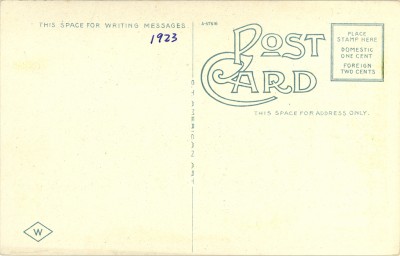

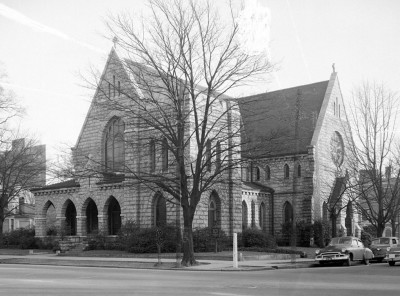
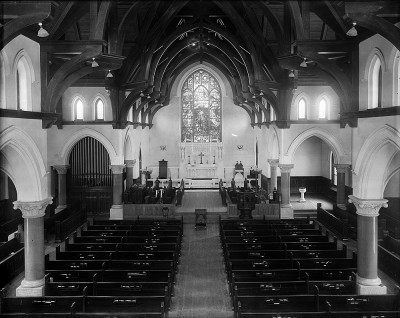
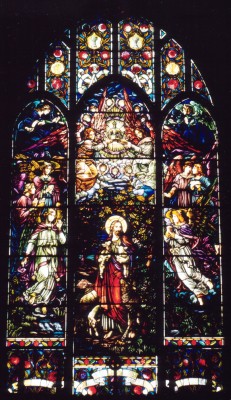
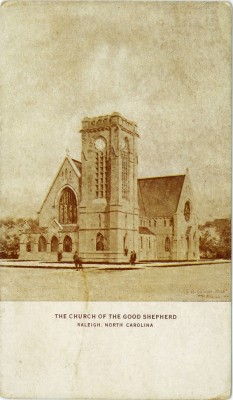
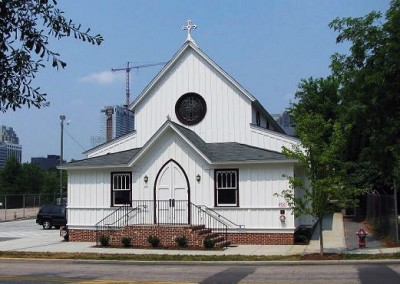
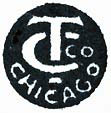
 Sign up for the Newsletter
Sign up for the Newsletter
08/30/2013
Here are some really chewy words: “The sumptuous interior of the Church of the Good Shepherd is supported by a massive oaken hammer-beam ceiling, and is embellished with opulent stained glass windows, polished pink granite columns and a marble altar and reredos.”
Those words fit well, too. I’ve always admired this structure, and the church’s name is spot-on. It’s almost enough that I could consider becoming Episcopalian.
Thanks, Karl.
08/30/2013
I’ve always heard this was referred to pejoratively by members of Christ Church as the “Yankee church.” Ha!